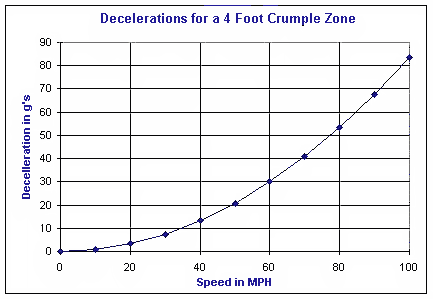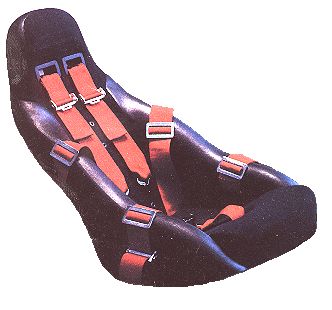SkyTran Emergency Safety Considerations, Part 2
GREEN is SAFE , YELLOW is getting into the INJURY ZONE and RED is DEAD ).This table is ONLY for a person who has the full protection of wearing a seat belt with shoulder harness plus a working air bag - not just a seat belt or seat belt/shoulder harness combination (which doesn't really keep your head from snapping forward violently). If nothing else, the table should tell you to always wear your seatbelt and shoulder harness and if possible own a modern car with air bags in order to have that non-injury 60 "g" capability! The designed in crushability of modern cars cannot do you any good if you are a separate, non-attached object!We will use this page to help you understand why a 6 "g" deceleration capability is extremely desirable. First, simply consider just how many of the 40,000 people who get killed on our nations highways every year would still be alive - if cars could really stop super fast - like at 6"g's" instead of 0.4 "g's" (15 times the stopping power!).
Engineering Compromises: Safety Vs Price
Like most engineering inventions an automobile is a lot of compromises - which have to do with costs and what the customer is willing to pay. We obviously have the technology to install a retro rocket in every car. So why don't we? Think of all the lives it could save if it could be used just once for that serious emergency stop. BUT, would people be willing to pay another $7,500 for their cars?? AND what happens in a side crash when the rocket propellant tank splits wide open, the liquid spills and eats up peoples skin? Not a good idea! For many similar reasons we are probably stuck with the existing coefficient of friction between rubber and asphalt for automobiles (BUT not for Personal/Mass Transportation!)Controlled High Deceleration VS a Crashing Impact
Keep in mind that decelerating at 6"g's" is NOT the same as crashing! A crash from 100 MPH into a solid object that results in say a 4 foot of vehicle front compartment deformation means the passengers inside (if securely fastened in) also decelerate from 100 MPH to zero MPH in 4 feet! (Remember the pictures of Princess Diana's Mercedes - that was about 4 foot of deformation. Can the table below give you some clues why the body guard survived with grave injuries, while the others didn't?) Especially keep in mind, however, if the people are NOT securely fastened in - then they have 100 MPH of stored energy and their bodies keep traveling until they separately impact against the inside of the now stopped (smashed) car structure. Do their bodies now totally decelerate in just 2 inches if they hit solid steel? Or maybe is it a larger 6 inches if they impact a cushioned dash? The table below shows the awful consequences of not strapping in and then having to fully decelerate in just a couple of inches!Deceleration Table
This table shows deceleration effects for rapid to near instant stops from 100 MPH, 60 MPH and 30 MPH. (
|
Stopping Distance (feet) |
Required Average g's from 100 MPH |
Required Average g's from 60 MPH |
Required Average g's from 30 MPH |
|
55.6 |
6.0 |
2.2 |
0.5 |
|
50 |
6.7 |
2.4 |
0.6 |
|
40 |
8.4 |
3.0 |
0.8 |
|
30 |
11.1 |
4.0 |
1.0 |
|
20 |
16.7 |
6.0 |
1.5 |
|
10 |
33.4 |
12.0 |
3.0 |
|
5 |
66.8 |
24.0 |
6.0 |
|
2 |
167.0 |
60.1 |
15.0 |
|
1 |
334.0 |
120.2 |
30.1 |
|
0.5 |
668.0 |
240.5 |
60.1 |
|
0.333 |
1002.2 |
360.8 |
90.2 |
|
0.167 |
2004.9 |
721.8 |
180.4 |
(Note: 0.5 foot = 6 inches ; .333 foot =
4 inches; and .167 foot = 2 inches)
Again, the above graph tells you that you have to sprrreadd out the
necessary deceleration over as much distance as possible during a stop! If
it all happens in too short of a distance we now call it a crash instead of
a stop! Not wearing seat belts and counting on an air bag alone to save you
is being lazy and stupid.
The absolute best solution to crash protection idea I've ever seen was the "Insta-Foam" used in the Sylvester Stallone, Sandra Bullock movie "Demolition Man". Stallone crashes his futuristic car and is totally unhurt because he was entirely encased in Styrofoam - instantly. The perfect protection solution! (HAH! Only if you can't decelerate at controlled higher "g's" than rubber on asphalt allows.) Unfortunately, it was just a cute hypothetical special effect.
Four Foot Stops
The following graph shows the steady deceleration needed to stop in exactly four feet while moving at any speed between 0 and 100 MPH. You can see it takes about 21 "g's" if you are going 50 MPH and about 84 "g's" if you are going 100 MPH. The graph on the previous page tells us that if you were using the full restraint system with an air bag that you would be very safe decelerating from 50 MPH in just 4 feet, but would be in the threshold between bad injury and death if you stopped in 4 feet from 100 MPH. (Note: This has nothing to do with simulating hitting the brakes as you see you are going to impact a solid concrete wall. This is hitting the wall without ever slowing down. The front of the car's structure acts as an energy absorber that collapses exactly 4 feet before the more or less intact passenger compartment comes to rest.)

The picture below is a picture of RACE CAR four point harness restraint system. Note there is even an extra belt between your legs to keep you from sliding out from under the restraint system in a hard crash. Can you guess why these serious belts are so wide compared to what we get in our automobiles? Can you also guess why we don't use seat belts made out of 1/16th inch diameter high strength steel wire that would be cheaper to make and could even help lower the price of all cars a bit? Could you also maybe predict that if your car had such a restraint system (much wider belts with the extra anti-slide-out strap) that the non-injury threshold would even be higher than the chart values (MMM? Do race cars contain air bag systems nowadays? Should they?)
So what does all of the above have to do with SkyTran ?
1. Using a 6 "g" deceleration mode for emergency stops keeps the old time train people who are fanatics about their idiotic, non-realistic laws at bay. Another nice thing about the above ground SkyTran vehicles is that they don't require train-like right-of-way gates systems. Regular trains selfishly consume the time of all automobile commuters stuck waiting at the gates, while simultaneously causing unnecessary pollution from idling engines and once the gates go up from the extra power needed to accelerate the cars back to efficient cruise speeds .
Also, trains regularly kill people (especially those too impatient to wait). The last data I gathered showed 16 killed in Orange County, 32 in Los Angeles County and 13 in San Diego County in 1992.
On October 27, 1997 two sisters aged 3 and 22 months were killed by a 450 ton Metrolink train traveling at 40 MPH. According to the Orange County Register "The engineer sounded the horn and executed an emergency stop, but it took 3/4 of a mile for the train to come to a halt." Such disgusting deceleration capability in this technological day and age should not be tolerated! How come the train passengers get the privilege of 1/8th maximum "g" decelerations to protect them, so they can safely be walking in the aisles anytime at the expense of the lives of these two little girls and how many others. Train passengers should be seat belted in all the time and only allowed to walk around when the trains are stopped. Then the trains could be reworked to have some logical braking capability.
More recently, on March 30, 1998, "Train kills man, 29, walking on tracks". "The train engineer spotted Castro from a mile away, but could not stop in time."2. I had to educate you, so you won't protest or question why having to wear a seat belt/shoulder harness every time you ride in a SkyTran vehicle is essential.
3. Disaster Safety: One example tells the rest of the story. Imagine a SkyTran monorail track running along side a 3 lane freeway. Boom - a 747 falls out of the sky and smashes into the freeway and the monorail track ahead. Because of the 6"g" braking capability of the Pods - only a 55.6 feet length of Pods traveling at 100 MPH (one Pod) slides into the inferno before the others can stop, whereas 352 feet of cars traveling at 65 MPH (10.5 cars) can't get stopped before entering the inferno. (Won't even include stupid trains in this mathematical scenario - with their rotten braking capability they all get to become crispy critters.)
